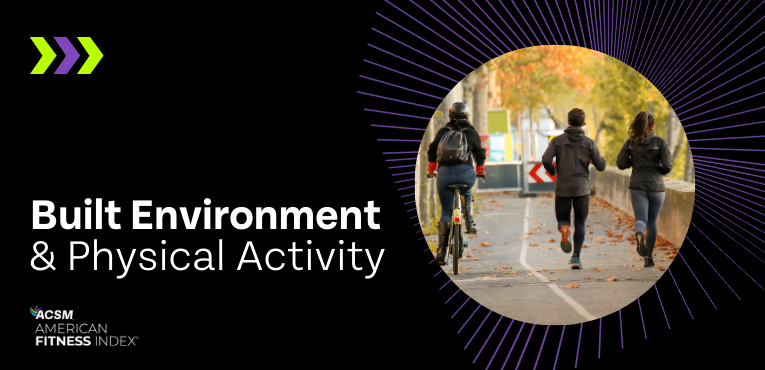Stella L. Volpe, Ph.D., RDN, ACSM-CEP, FACSM |
June
12, 2024
 It has been well-established that physical activity and/or exercise can help to reduce the risk of chronic diseases such as obesity, diabetes, cancer and cardiovascular disease.
It has been well-established that physical activity and/or exercise can help to reduce the risk of chronic diseases such as obesity, diabetes, cancer and cardiovascular disease.
To reap these benefits, we only need to accumulate 150 minutes per week of physical activity1. That means that you can be physically active for as little as 10 minutes at a time to accumulate 30 minutes in a day for five days, or be active for about 20 minutes per day for seven days. Even though accumulating physical activity in small increments is just as good for our health as being physically active in one longer bout, many people still find it difficult to incorporate physical activity and/or exercise into their lives.
Despite public health efforts to encourage more physical activity among the population, the Centers for Disease Control and Prevention (CDC) state that only about 28% of individuals exercise on a regular basis1. However, if the environment was such that it allowed individuals to be more physically active more naturally, perhaps more individuals would meet physical activity recommendations.
Research on the affects of built environment
The built environment has been shown to have an effect on physical activity. For example, cities that have bike lanes, accessible parks, sidewalks and walking trails typically have higher levels of physical activity among their citizens. Conversely, cities that lack these features, tend to have lower physical activity levels among their residents. Other variables also come into play, including resources to make changes to the built environment, safety, lighting and the weather.
Some researchers wanted to identify which changes to the built environment increase physical activity in residents at the local level, taking into account cost and socioeconomic status. It was found that enhancements to the infrastructure of a city tended to benefit those of lower socioeconomic status. It appears that improvements in walkability, enhancing parks and playgrounds, and having sufficient active transport within a city will increase physical activity in both children and adults2,3. This is encouraging, because increasing physical activity among all ages is important for the health of our population.
Although increasing physical activity, and subsequently improving overall health among all ages is important, some researchers have studied whether changes in the built environment specifically increased physical activity levels in older adults (greater than 65 years of age). They found that the factors that led to increased physical activity in older adults included: walkability, how well streets connect, mixed land use, access to facilities, services available, street lighting, having more accessible green space and crime- and traffic-related safety4. It is important that cities take into account all of these variables when they are making decisions about improving infrastructure. The health of their citizens needs to be at the forefront in their decision making. In doing so, not only will this decrease healthcare costs, but it will attract more people to want to visit or reside in that city, helping the economy.
Even if cities have good built environment infrastructure, it may not lead to increases in physical activity for all. For example, in neighborhoods of low-income it has been reported that when women went to parks, it was largely for the purpose of taking their children to play, whereas men typically went to parks for their own physical activity. Furthermore, it was found that older adults did not get to parks as much as they would like because many of the facilities for them were inadequate5.
Adding green (grass) and blue (water) spaces can also lead to greater physical activity. Some researchers found that putting grass on hard spaces in school yards led to increased physical activity and improved social well-being among children in elementary school6.
The built environment is extremely vital for both physical activity and social interactions, leading to improved physical and mental health. When making decisions for city infrastructure renovations, policy makers should empower their citizens to help make informed decisions based on age, sex and socioeconomic status. Even if parks have meeting places where people may only go to sit and talk with their friends or play chess, this can still result in more physical activity than if people were to remain at home. If citizens are empowered to help make decisions for their cities and towns, they are more likely to use the facilities, leading to healthier lives.
Author: Stella L. Volpe, Ph.D., RDN, ACSM-CEP, FACSM
Chair, American Fitness Index
President-elect, American College of Sports Medicine
Originally published on October 30, 2023
References
- Centers for Disease Control and Prevention. https://www.cdc.gov/physicalactivity/basics/adults/index.htm
- Smith M, Hosking J, Woodward A, et al. Systematic literature review of built environment effects on physical activity and active transport – an update and new findings on health equity. Int J Behav Nutr Phys Act. 2017;14(1):158.doi: 10.1186/s12966-017-0613-9.
- Laddu D, Paluch AE, LaMonte MJ. The role of the built environment in promoting movement and physical activity across the lifespan: Implications for public health. Prog Cardiovasc Dis. 2021:64:33-40. doi: 10.1016/j.pcad.2020.12.009.
- Bonaccorsi G, Manzi F, Del Riccio M, et al. Impact of the built environment and the neighborhood in promoting the physical activity and the healthy aging in older people: An umbrella review. Int J Environ Res Public Health. 2020;17(17):6127. doi: 10.3390/ijerph17176127.
- Cohen DA, Han B, Park S, et al. Park use and park-based physical activity in low-income neighborhoods. J Aging Phys Act. 2019;27(3):334-342. doi: 10.1123/japa.2018-0032.
- Raney MA, Hendry CF, Yee SA. Physical activity and social behaviors of urban children in green playgrounds. Am J Prev Med. 2019;56(4):522-529. doi: 10.1016/j.amepre.2018.11.004.